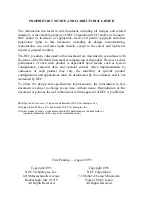
-
12 -
Option: Remote Control
(Tip Jack "Remote Control")
If the charger has been installed in a difficult to access location, the
Remote Control S for Automatic Charger (Order No. 2075)
can be used for remote control of
the charging process (plug-and-go connection cable of 5 m length is included in the delivery
scope).
Connection:
Just insert the plug of the remote control into the tip jack "Remote Control" of the charger.
Function:
The remote control is equipped with the same pilot lamps (light-emitting diodes)
as the charger.
Switch Function:
Position "ON": Charger works with full charging capacity.
Position "OFF": Ensures silent operation on board by means of the function "silent run",
noise-optimised operation (night operation), see page 5.
Lead-Acid
Batteries, Special Program
"Equalization":
During the normal charging mode an equalization charging of the battery is effected during the time-controlled charging
phase U1/U2, as well as in case of longer rest periods with the phase "battery regeneration".
Additionally, the charger can be set to the special operating mode
manual equalization charging
, which means, that a
calculated overcharging of the battery will be effected to get the same level of charging for all individual battery cells. For
this purpose, a reduced current will be supplied to the battery, which has been fully charged already before. The produced
strong gassing in the battery effects a good acid mixing and reactivation of the chemical surfaces.
For reasons of safety, the charger keeps a low current rate, the maximum charging voltage is limited to 16.0 V, and the
whole process will be aborted automatically after 1.5 hours.
This process is only suitable for lead, acid/lead-acid batteries with removable cell plugs
(If required, an acid
level control and acid level correction can also be effected, if:
The battery has been deeply discharged.
In case of insufficient charging (the charging process has been interrupted too often already during the
charging phase I or U1, the charging process has not been completed entirely).
Lead Equalization Process:
1.
Only with switch position 2) "Engine 14.2 V". Check the correct position for the battery type! For any other battery
type, this function is blocked for safety reasons!
2.
Charge the battery (batteries) fully
by means of a standard charging process (approx. 3 to 15 hours) until the
indicator "Battery Full" is permanently on.
3.
Switch-off ALL consumers.
(Charging voltage might raise up to 16.0 V. This might be disadvantageous for the
consumers, and the consumer current might falsify the effect at the battery!)
4.
Separate the charger from mains
(withdraw unit plug on the rear) and open cell pug of the battery
.
5.
Press and keep the
key
"1s Silent Run / 4s Li Storage /
Equal.
" pressed, while reinserting the unit plug. Keep the key
pressed for a further moment (but not too long), until both indicators "Battery I" and "Battery II" are flashing. The
charger is now in the operating mode "Equalization".
6.
The charging current is approximately 1/8 of the normal maximum current of the charger, and it will be kept
constant. The battery voltage will be increased gradually. However, the charger limits to max. 16.0 V.
7.
The battery (batteries) will gas strongly. Therefore, the battery room is to be ventilated particularly well
(formation
of explosive detonating gas)!
8.
Supervise the temperature of the battery (batteries)! The temperature sensor is also active during the
"Equalization". In case of excessive battery temperature, the safety voltage will be reduced and virtually no charging
current is flowing any more.
9.
After approx. 1.5 hours the charger terminates the process automatically, it switches-off completely, and only the
indicator "Power" is flashing. Withdraw the mains plug for a short moment and close the cell plug again.
10.
Finished. Reinsert the mains plug. The normal charging process is started again.


































